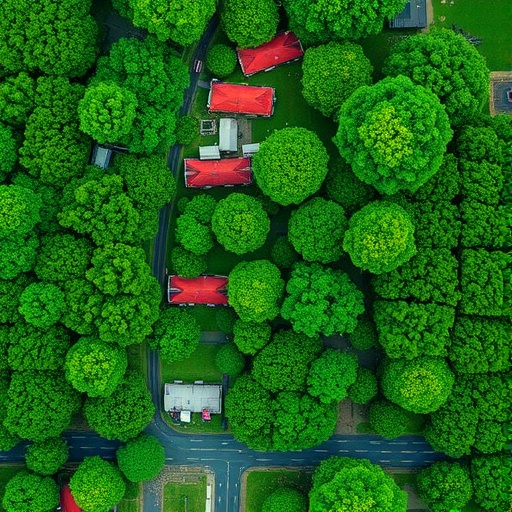In recent years, the need for sustainable urban forest management has become increasingly critical amid global climate change and urbanization. The study of urban forests not only provides ecological benefits, such as improved air quality and biodiversity, but also enhances the quality of life for residents in metropolitan areas. A groundbreaking research article, titled “Comparative evaluation of Landsat 9 vegetation indices for estimating urban forest biomass in the botanical garden of University of Ibadan, Nigeria,” by Israel, R., Akintunde-Alo, D.A., and Oluwajuwon, T.V., delves into innovative methodologies for assessing urban forest biomass, a key component of understanding forest health and dynamics.
At the core of this research is the application of Landsat 9 satellite imagery, which is uniquely equipped with advanced sensors capable of capturing high-resolution data on Earth’s surface over time. This satellite collects crucial information regarding vegetation cover, health, and growth, which can be processed using various vegetation indices. By employing these indices, the article evaluates their effectiveness in determining the biomass of urban forests, specifically focusing on a vital ecological area – the botanical garden of the University of Ibadan.
The choice of the botanical garden as a focal point reflects its significant role in the local ecosystem and educational landscape. Urban forests, including botanical gardens, serve as crucial green spaces that mitigate urban heat, improve air quality, and support a variety of flora and fauna. Understanding the biomass within these areas allows researchers to make more informed decisions regarding conservation and urban planning efforts to sustain these essential resources.
One of the pivotal aspects of the study is the selection of vegetation indices used for biomass estimation. Commonly used vegetation indices such as the Normalized Difference Vegetation Index (NDVI) and the Enhanced Vegetation Index (EVI) have shown promise in previous studies regarding forest biomass estimation. However, the introduction of Landsat 9 provides a new avenue for exploring additional indices, potentially increasing the accuracy of biomass estimates.
Training and validation sets were established using ground truth data collected from the botanical garden. This process is vital, as it ensures that the satellite-derived estimates align closely with on-the-ground measurements. Advanced statistical methods, including machine learning algorithms, were employed to refine the estimates further. Machine learning’s capacity to analyze complex and high-dimensional datasets allows for more accurate predictions concerning forest biomass and highlights the necessity of incorporating technological advances in ecological research.
Interestingly, the study reports that Landsat 9’s enhanced capabilities significantly improve vegetation detection compared to its predecessors. The integration of shortwave infrared bands provides critical insights into vegetation health that were not as accessible with earlier models. This advancement opens the door for researchers worldwide to employ satellite data more effectively, potentially affecting various studies aimed at ecological preservation and urban forestry management.
Additionally, the paper presents a thorough comparison of the different indices employed in the analysis. Each index has its strengths, with some being more effective in capturing specific biomass characteristics. For instance, while NDVI is widely recognized for its ease of use and reliability, EVI was found to provide better results in areas with high biomass density. The choice of index can thus markedly affect the outcomes of biomass estimations, emphasizing the need for precise methodologies in ecological studies.
The implications of this research extend well beyond academic circles. Urban planners, conservationists, and policymakers can benefit significantly from accurate biomass estimation in urban forests. Such data can inform decisions regarding resource allocation, conservation strategies, and community engagement efforts. For example, areas identified as having high biomass could be prioritized for preservation, ensuring the longevity of their ecological benefits.
Furthermore, the article proposes future research directions that could enhance the understanding of urban forest dynamics. One area is the continued exploration of integrating multisource data, including LiDAR, drones, and socioeconomic datasets, into analyses of urban forests. By adopting a multi-faceted approach, researchers can better unravel the complexities that define urban ecosystems and their interactions with human populations.
As urbanization continues to shape landscapes around the world, the significance of studies such as this cannot be overstated. They serve as a reminder of the intricate connections between technology, ecology, and urban living. Engaging communities in discussions surrounding urban forestry can foster a collective responsibility towards maintaining these vital green spaces.
In conclusion, the research conducted by Israel, Akintunde-Alo, and Oluwajuwon represents a critical step forward in the quest for effective urban forest management. By employing advanced satellite technology and robust analytical methods, the study not only sheds light on the present state of urban biomass in Nigeria but also sets a foundation for future explorations in other regions. The interplay between advanced remote sensing technology and local ecological studies paints a hopeful picture for the role of urban forests in combating climate change and enriching urban life.
Ultimately, the findings underscore the pressing need for a concerted global effort to value and preserve urban forests, leveraging innovative technologies to support sustainable urban development. As the research demonstrates, urban forests are not merely patches of green amid concrete jungles; they are vital components of urban ecosystems that contribute crucially to public health, biodiversity, and environmental resilience.
Through studies like these, we can aspire to nurture and protect urban forests, ensuring that they continue to thrive for generations to come, standing as vital landscapes overcoming the challenges posed by rapid urbanization and climate change. It won’t just be a scientific endeavor but a mission towards enhancing the livability and sustainability of cities around the world.
Subject of Research: Urban forest biomass estimation using satellite-derived vegetation indices.
Article Title: Comparative evaluation of Landsat 9 vegetation indices for estimating urban forest biomass in the botanical garden of University of Ibadan, Nigeria.
Article References:
Israel, R., Akintunde-Alo, D.A. & Oluwajuwon, T.V. Comparative evaluation of Landsat 9 vegetation indices for estimating urban forest biomass in the botanical garden of University of Ibadan, Nigeria.
Discov. For. 1, 32 (2025). https://doi.org/10.1007/s44415-025-00031-2
Image Credits: AI Generated
DOI:
Keywords: Urban forestry, biomass estimation, Landsat 9, vegetation indices, ecological health.




